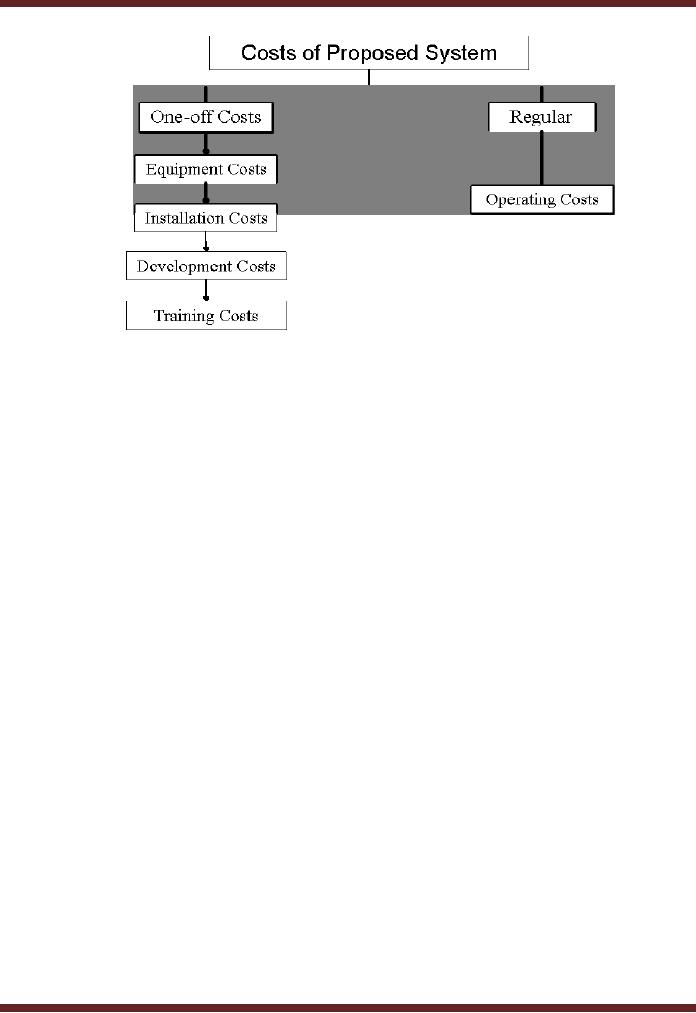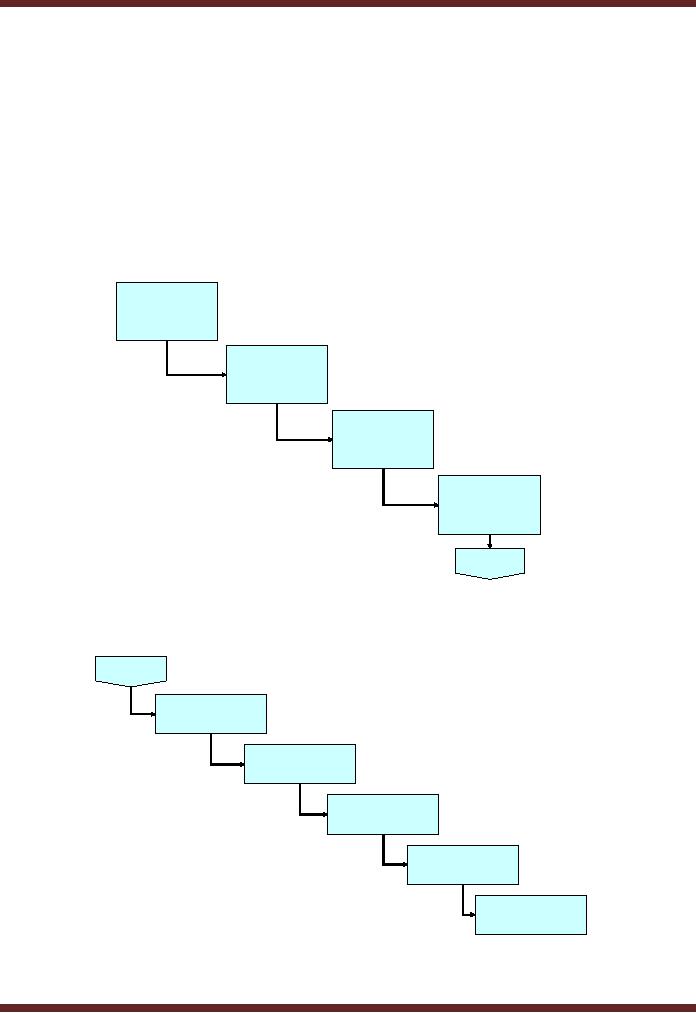 |

VU
Information
System (CS507)
LESSON
18
Systems
Development Life Cycle
System
Development Life Cycle (SDLC) is the
overall process of developing
information systems through
a
multi-step
process from investigation of initial
requirements through analysis,
design, implementation
and
maintenance.
SDLC is also known as
information systems development or
application development. SDLC
is a
systems approach to problem solving
and is made up of several
phases, each comprised of
multiple
steps.
It describes the stages a system
passes through from
inception until it is discarded or
replaced. SDLC
provides
1.
Structure
2.
Methods
3.
Controls
4.
Checklist
18.1
Project lifecycle vs.
SDLC
The
systems development life cycle is a
project management technique that divides
complex projects into
smaller,
more easily managed segments
or phases. Segmenting projects
allows managers to verify
the
successful
completion of project phases before
allocating resources to subsequent
phases. Although
System
development
can be seen as a project in itself,
but the attribute that makes
system development different
from
regular projects is that a
project has a definite end
and it is unlikely that
ongoing maintenance will
be
included in the
scope of the project but this
falls in the definition of SDLC.
18.2
Types of System Development Life-Cycle
Model
The
concept of system development lifecycle
model has been explained in various
shapes and forms. The
concluding
form follows the same spirit
except for minor
differences.
Waterfall
model / Classic lifecycle/
Linear Sequential
Model
The
waterfall model is a software development model (a
process for the creation of software) in
which
development is
seen as flowing steadily
downwards (like a waterfall) through the
various phases
Incremental
Models
In
incremental models, software is
built not written. Software
is constructed step by step in the
same way a
building
is constructed. The products is designed,
implemented, integrated and tested as a
series of
incremental
builds, where a build consists of
code pieces from various
modules interacting together to
provide
a specific functional capability and
testable as a whole.
Iterative
Models
In
these models customer feed
back is taken at each phase
and project is modified
accordingly if need
be.
71

VU
Information
System (CS507)
Prototypes
are used in these
models.
Need
Assessment
Information
systems are usually developed on
need-basis, that is,
problems and opportunities
arise and
render
system development necessary. In this
phase the stakeholders must attempt to
come to some
understanding
of the nature of the problem or
opportunity they are addressing.
Issues which can be
considered
in this phase are. Is the
problem
�
Well
structured/Structured -- constrained problems
with convergent solutions, limited number of
rules
and
principles within well-defined
parameters.
�
Unstructured --
multiple solutions, fewer parameters,
and contain uncertainty about which
concepts and
rules.
Should
formal terms of reference be
prepared and approved by the steering
committee or project
committee?
This depends on the size,
impact and cost of the
system being prepared. The
TOR usually
covers
following aspects.
�
Investigation
on existing system
�
Definition
of system requirements
�
Specifying
performance criteria for the
system
�
Detailed
cost budget
�
Draft
plan for implementation
If the
problem is decided to be addressed, the
level of acceptance that exists
among the stakeholders on the
need
of change. The level of technological uncertainty the
proposed solution to the
problem/opportunity
has.
The most critical phase is the
agreement of the stakeholders on the
definition of problem
and
parameters
of solution.
Entry
and Feasibility Study
The
purpose of this phase is to obtain a
commitment to change and to evaluate
whether cost effective
solutions
are available to address the
problem or opportunity that
has been identified.
Following examples
can be
considered to explain this situation.
�
Say a
problem has been recognized
by a group of users. They believe they
can design and implement
a
solution
themselves using a high level
language. Their proposed system
will have little impact on
others
within
the organization, nor will it be material
from the viewpoint of the overall
organization. In this
situation, the
users are already motivated
to bring about change. Thus
activities to accomplish
successful
entry
are minor or
unnecessary.
�
On the
other hand, consider a
solution where potential solutions
will have a widespread
impact on the
overall
organization. Activities to accomplish
successful entry are now
critical. Information systems
professionals
must seek to establish
themselves as legitimate change agents
among the stake
holders.
Moreover
they must seek to foster among the
stakeholders a commitment to change. If
potential
solutions
will have a significant impact on
task and social systems, a
spirit of collaborative analysis
and
evaluation
among stakeholders must be
developed.
Once
the entry is successful, a preliminary
study can be carried out to
evaluate the feasibility of the
new
system.
A Feasibility study team should be
constituted
�
Draw
representatives from the departments
affected by the project
72

VU
Information
System (CS507)
�
At
least one person must
have a detailed knowledge of computers
and systems design (called
system
analyst).
�
At
least one person should have
a detailed knowledge of
�
The
organization
�
How
current system operates
�
Information
needs of the system
�
Defects
in the existing system
�
Consultants
from the outside
Key
Areas of Feasibility
Following
aspects/criteria can be covered in a
feasibility study.
�
Technical
Feasibility is the available technology
sufficient to support the proposed
project? Can the
technology be
acquired or developed?
�
Response
times time between request
and execution
�
Volume
of transactions which can
processed within the given time
�
Capacity
to hold files or records of a certain
size
�
Number
of users supported without
execution
�
Operational
Feasibility
compliance and adjustability with the
way organization works with attitude
to
change
or chains of command.
�
Can
the input data be collected
for the system?
�
Is the
output usable?
�
Economic
feasibility Do the
benefits of the system exceed the
costs?
It should be the
BEST OPTION among those under
consideration for the same
purpose.
�
Behavioural
feasibility What impact
will the system have on the
user's quality of working
life?
�
Reduction is
job stress
�
Job
satisfaction
�
Quality
of output by employees
18.3
Costs of Proposed
System
73

VU
Information
System (CS507)
18.4
Benefits from the proposed
system
When a
system is being introduced, management should
consider the impact and amount of
proposed
benefits.
The purpose of this activity is to
consider and
�
Better
decision making
�
Savings
�
Possible
in staff costs through increase of
efficiency and not necessarily
through redundancies.
�
In
costs of running the department through
more organized and efficient
computerisation.
�
More
sales revenue
�
Efficient
use of staff time
�
Customer
satisfaction
�
Better
planning of resources required for
operations e.g. inventory ordering, fixed
asset utilization.
18.5
Classic lifecycle Model / Waterfall
Model
Waterfall model is
the earliest of software process
models. Cascade of phases, the
output of one is input
to
the next.
The waterfall model is a software development model (a
process for the creation of software)
in
which
development is seen as flowing steadily
downwards (like a waterfall) through the
various phases.
Various
phases of waterfall model are
�
Need
Assessment
�
Entry
and feasibility study
�
Analysis
of the existing system
�
Information
processing systems design
This also includes
�
Formulation
of strategic requirements
�
Organizational
& job design
74

VU
Information
System (CS507)
�
Program
Development this includes
�
Application
software acquisition & development
�
Hardware/system
software acquisition
�
Procedures
development
�
Testing
�
Conversion
�
Operating &
maintenance
Waterfall
Model
Need
Assessment
Entry
&
Feasibility
Study
System
Analysis
System
Design
Next
1
Waterfall
Model
Previous
Program
Development
Procedures
Development
Testing
Changeover
Operations
&
Maintenance
15
75

VU
Information
System (CS507)
Two
phases need assessment and
feasibility study, have
already been explained in detail. Now
let's take a
look
at other phases one by
one.
18.6
Analysis of Existing
system
Once
feasibility has been drawn up,
next stage comes for
analysis of existing system. Even if the
existing
system
is to be replaced the designers must
study the existing system as this improves the
quality of the
work.
For example
The
new system may change the
way employees are rewarded.
In such a case the redistribution of
rewards
may
have to be carefully negotiated. Concerns
of employees cannot be ignored. Analysis is a
two-part
episode.
Studying organization's history, structure, culture this
would help to
understand
�
The
social & task
systems
�
The
way systems are
coupled
�
Willingness
of stakeholders to change (Change
Management to be discussed
later)
The
greater the impact of the new
system, greater time should be spent in
understanding the present
organization.
Analysis of existing product &
information flows. This includes the
use of various tools
for
documenting the
existing system. What these tools
are will be discussed in detail in later
Lessons.
System
Design
System
design includes the desired
features and operations in detail,
including screen layouts,
business rules,
process
diagrams other documentation. It involves
converting the informational, functional,
and network
requirements
identified during the initiation
and planning phases into
unified design specifications.
This
includes
�
Formulation
of strategic requirements
�
Organizational
& job design
�
Elicitation
of detailed requirements
�
Design
of the information flow
�
Design
of database
�
Design
of user interface
�
Physical
design
�
Design
of hardware & software
platform
Formulation
of Strategic Requirements
The
overall goals and objectives
the system must accomplish.
Forms can be accomplished in
any form, for
instance:
�
A
vague goal increase in the wealth
of shareholders
�
A
specific goal reduce staff
turnover by 30%
Strategic
requirements for the new
system are identified based
on perceived deficiencies of existing
system.
Trying
to fit people and organizations
into information systems has
been major reason for failure.
If
strategic
requirements are clear,
stakeholders are better placed to
consider and evaluate alternative
designs.
Organizational
& Job Design
76

VU
Information
System (CS507)
Change
in the strategic requirements will
necessitate the change in the following
for the parts of the
organization being
affected
�
Organizational
structure
�
Job
descriptions for new or
change in existing ones
Trying
to fit people and organizations
into information systems has
been major reason for failure.
So
change
in both the above is important. If
uncertainty surrounds the tasks to be
accomplished in the
proposed
system, loose organic organizational
structures and job designs
might be successful. Such
promote
creativity
and innovations. If organization is dominated by
top management and culture is
autocratic,
employees
might be unwilling to accept the
high level of responsibility.
18.7
Elicitation of Detailed
Requirements
Designers
must understand
�
What
information an IS must
provide
�
The
data that must be captured
to produce this information
Two
approaches can be
followed
�
Ask
the stakeholders what they require helps when
they are clear about the requirements
on
the
basis of past experience or
good understanding.
�
Analysis
& experimentation Where the ones
bearing interest are not
clear or have no past
experience,
onus falls on the designer to
work out the
requirements.
77
Table of Contents:
- Need for information, Sources of Information: Primary, Secondary, Tertiary Sources
- Data vs. Information, Information Quality Checklist
- Size of the Organization and Information Requirements
- Hierarchical organization, Organizational Structure, Culture of the Organization
- Elements of Environment: Legal, Economic, Social, Technological, Corporate social responsibility, Ethics
- Manual Vs Computerised Information Systems, Emerging Digital Firms
- Open-Loop System, Closed Loop System, Open Systems, Closed Systems, Level of Planning
- Components of a system, Types of Systems, Attributes of an IS/CBIS
- Infrastructure: Transaction Processing System, Management Information System
- Support Systems: Office Automation Systems, Decision Support Systems, Types of DSS
- Data Mart: Online Analytical Processing (OLAP), Types of Models Used in DSS
- Organizational Information Systems, Marketing Information Systems, Key CRM Tasks
- Manufacturing Information System, Inventory Sub System, Production Sub System, Quality Sub system
- Accounting & Financial Information Systems, Human Resource Information Systems
- Decision Making: Types of Problems, Type of Decisions
- Phases of decision-making: Intelligence Phase, Design Phase, Choice Phase, Implementation Phase
- Planning for System Development: Models Used for and Types of System Development Life-Cycle
- Project lifecycle vs. SDLC, Costs of Proposed System, Classic lifecycle Model
- Entity Relationship Diagram (ERD), Design of the information flow, data base, User Interface
- Incremental Model: Evaluation, Incremental vs. Iterative
- Spiral Model: Determine Objectives, Alternatives and Constraints, Prototyping
- System Analysis: Systems Analyst, System Design, Designing user interface
- System Analysis & Design Methods, Structured Analysis and Design, Flow Chart
- Symbols used for flow charts: Good Practices, Data Flow Diagram
- Rules for DFD’s: Entity Relationship Diagram
- Symbols: Object-Orientation, Object Oriented Analysis
- Object Oriented Analysis and Design: Object, Classes, Inheritance, Encapsulation, Polymorphism
- Critical Success Factors (CSF): CSF vs. Key Performance Indicator, Centralized vs. Distributed Processing
- Security of Information System: Security Issues, Objective, Scope, Policy, Program
- Threat Identification: Types of Threats, Control Analysis, Impact analysis, Occurrence of threat
- Control Adjustment: cost effective Security, Roles & Responsibility, Report Preparation
- Physical vs. Logical access, Viruses, Sources of Transmissions, Technical controls
- Antivirus software: Scanners, Active monitors, Behavior blockers, Logical intrusion, Best Password practices, Firewall
- Types of Controls: Access Controls, Cryptography, Biometrics
- Audit trails and logs: Audit trails and types of errors, IS audit, Parameters of IS audit
- Risk Management: Phases, focal Point, System Characterization, Vulnerability Assessment
- Control Analysis: Likelihood Determination, Impact Analysis, Risk Determination, Results Documentation
- Risk Management: Business Continuity Planning, Components, Phases of BCP, Business Impact Analysis (BIA)
- Web Security: Passive attacks, Active Attacks, Methods to avoid internet attacks
- Internet Security Controls, Firewall Security SystemsIntrusion Detection Systems, Components of IDS, Digital Certificates
- Commerce vs. E-Business, Business to Consumer (B2C), Electronic Data Interchange (EDI), E-Government
- Supply Chain Management: Integrating systems, Methods, Using SCM Software
- Using ERP Software, Evolution of ERP, Business Objectives and IT
- ERP & E-commerce, ERP & CRM, ERP– Ownership and sponsor ship
- Ethics in IS: Threats to Privacy, Electronic Surveillance, Data Profiling, TRIPS, Workplace Monitoring